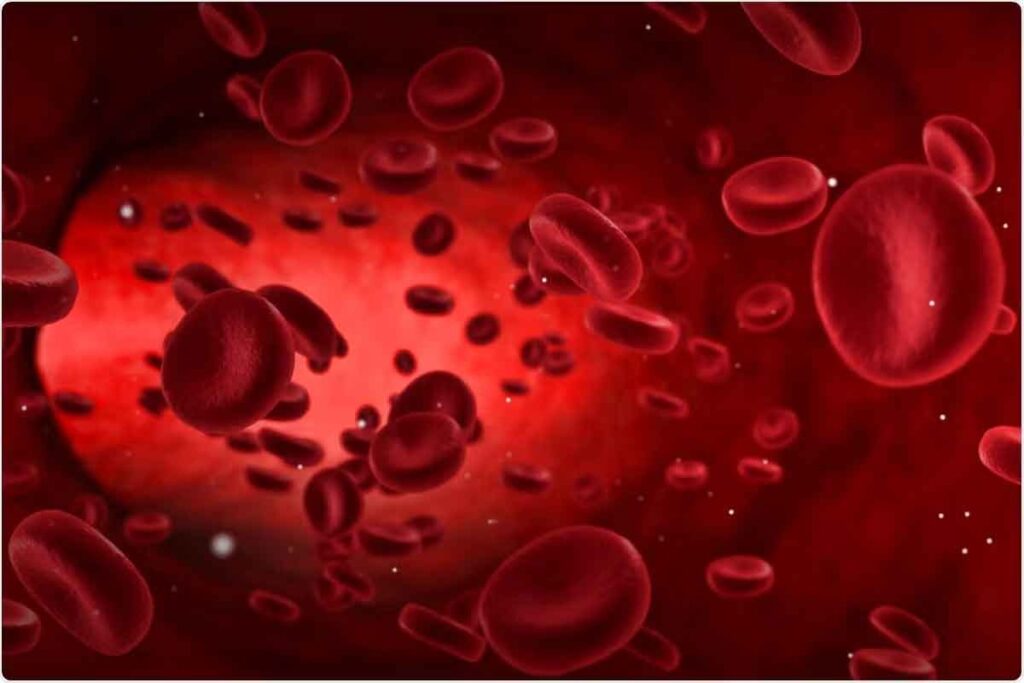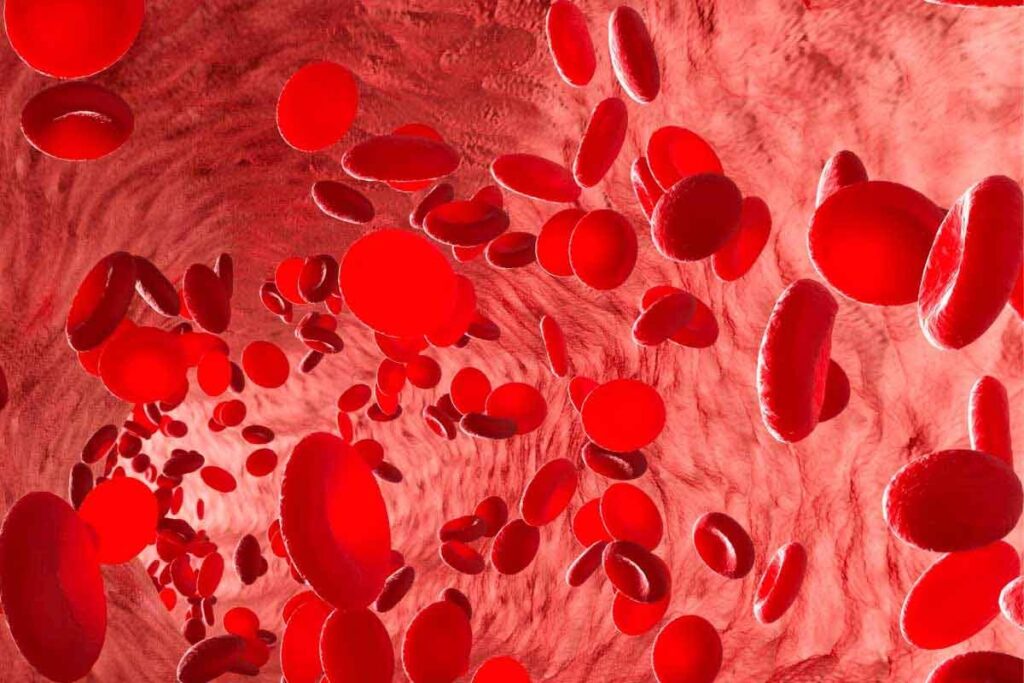Last Updated on October 21, 2025 by mcelik

Erythrocytosis is a condition where you have too many red blood cells. It can really affect your health. Knowing the causes and symptoms is key to handling it well.
Things like polycythemia vera or not getting enough oxygen can cause it. Spotting the signs and knowing how to treat it is important for staying healthy.
Liv Hospital is great at treating blood disorders like polycythaemia. Learning about erythrocytosis causes is the first step to managing its health effects.

Erythrocytosis is when your body makes too many red blood cells. This makes your blood thicker. It can harm your health and raise the chance of heart problems.
Erythrocytosis means you have too many red blood cells. It can happen for genetic reasons or because of lack of oxygen. Doctors use blood tests to find out if you have it.
It’s also called polycythemia. But some doctors use these terms differently. Knowing the medical words is key to getting the right treatment.
Having too many red blood cells makes your blood thicker. This can slow down blood flow. It also puts more pressure on your heart and raises the risk of blood clots, heart attacks, and strokes.
| Effects of Erythrocytosis | Health Implications |
| Increased Blood Viscosity | Impaired Circulation, Heart Strain |
| Higher Risk of Blood Clots | Increased Risk of Heart Attacks and Strokes |
| Potential for Cardiovascular Complications | Long-term Health Risks if Untreated |
Knowing the signs and risks of erythrocytosis is vital. It helps manage the condition better.

It’s important to know how red blood cells work to understand what happens when there’s too many. These cells carry oxygen to all parts of the body. They are key to keeping us healthy.
Red blood cells are made in the bone marrow. This process is called erythropoiesis. It involves many cells, growth factors, and hormones working together.
Erythropoietin, a hormone made by the kidneys, is very important. It tells the bone marrow to make more red blood cells. This keeps the body’s supply of these cells steady.
The body controls how many red blood cells it makes. When there’s less oxygen, the kidneys make more erythropoietin. This tells the bone marrow to make more red blood cells. This way, the body always has the right number of cells.
Erythropoietin is key in making sure we have enough red blood cells. It tells the bone marrow to make more cells. This keeps the blood healthy.
When there’s not enough oxygen, like at high altitudes, the body makes more erythropoietin. This leads to more red blood cells being made. It helps tissues get the oxygen they need.
Primary erythrocytosis is often linked to polycythemia vera. This condition makes the bone marrow produce too many blood cells. This can make the blood thicker, leading to serious health problems.
Genetic mutations play a big role in primary erythrocytosis, like polycythemia vera. The JAK2 V617F mutation is the most common. It affects the JAK2 gene, causing an abnormal protein that leads to too many blood cells.
This mutation is key in diagnosing polycythemia vera. Knowing the genetic cause helps doctors find better treatments.
Polycythemia vera affects more than just red blood cells. It also increases white blood cells and platelets. This makes it a complex disorder.
Symptoms of polycythemia vera include headaches, dizziness, and itching after bathing. It also raises the risk of blood clots because of the blood’s thickness.
It’s important to know the secondary causes of erythrocytosis for good treatment. Secondary erythrocytosis happens when something else makes the body make more red blood cells. Finding out what causes it is key to fixing the problem.
Chronic oxygen lack is a big reason for secondary erythrocytosis. Diseases like COPD cause the body to make more red blood cells. This is because the body needs more oxygen.
Chronic hypoxia also happens in heart failure or sleep apnea. Without enough oxygen, the body makes more red blood cells to get oxygen to tissues.
Being at high altitudes can also cause secondary erythrocytosis. At high places, there’s less oxygen in the air. The body makes more red blood cells to get enough oxygen to tissues.
Smoking is another big risk for secondary erythrocytosis. It harms the lungs and makes it hard to get oxygen. The Cleveland Clinic says quitting smoking is important for managing this condition.
“Smoking is a major risk factor for many cardiovascular diseases, and its effects on erythrocytosis are an additional concern for smokers.” –
Cleveland Clinic
Hormone problems can also cause secondary erythrocytosis. For example, tumors that make erythropoietin can make too many red blood cells. Some endocrine disorders can also raise red blood cell counts.
Knowing these secondary causes helps doctors create better treatment plans. By treating the underlying issue, doctors can manage secondary erythrocytosis and lower the risk of problems.
Many medical conditions can cause an increase in red blood cells, known as erythrocytosis. It’s important to know these conditions to get the right treatment.
Kidney disease is a major reason for secondary erythrocytosis. The kidneys make erythropoietin, a hormone that helps make red blood cells. If the kidneys are sick, they might make too much of this hormone.
This can lead to more red blood cells. Problems like kidney cysts or renal cell carcinoma can also cause this issue.
Certain tumors can also cause an increase in red blood cells. Tumors like hepatocellular carcinoma, uterine fibroids, and cerebellar hemangioblastoma can do this. They make substances that tell the body to make more red blood cells.
Other health issues can also raise red blood cell counts. For example, chronic obstructive pulmonary disease (COPD) and other conditions that cause chronic hypoxia can lead to this. So can some heart diseases and sleep disorders.
In summary, a high red blood cell count can be caused by many health problems. From kidney disease to tumors, knowing the cause is key to treating it right.
Erythrocytosis means having too many red blood cells. This makes blood thicker and more viscous. It changes how blood moves and how oxygen gets to tissues.
Blood viscosity is how thick and sticky blood is. More red blood cells make it thicker, like honey. This makes it harder for blood to flow.
The heart has to work harder to pump this thicker blood. It’s like trying to push through a thicker liquid.
The change in blood viscosity is more than just thickness. It affects how blood moves. Increased viscosity makes blood vessels more resistant. This can lead to heart problems if not treated.
Thicker blood affects circulation. It flows less well through blood vessels. This means less oxygen gets to tissues and organs.
Oxygen delivery is key for body functions. When blood is thicker, oxygen delivery drops. This can cause fatigue, dizziness, and shortness of breath.
In summary, too many red blood cells change blood viscosity. This affects circulation and oxygen delivery. Understanding these changes is key to managing erythrocytosis.
Knowing the signs of high red blood cells is key to finding and treating the cause. High red blood cell count, or erythrocytosis, can cause a range of symptoms. These symptoms can be mild or severe.
Early signs include headaches, dizziness, and blurred vision. These happen because the blood gets thicker, making it harder for oxygen to reach tissues.
Some people might feel tired, weak, or just not feel right. These symptoms are not specific but are important signs of possible health problems.
The skin might look ruddy or flushed because of more red blood cells. Visual changes, like seeing double or brief vision loss, are less common but can happen.
Neurological symptoms can happen because of less blood flow to the brain. This can lead to TIAs or even stroke. Cardiovascular symptoms include high blood pressure and a higher risk of blood clots.
| Symptom Category | Common Symptoms |
| Early Symptoms | Headaches, dizziness, blurred vision, fatigue |
| Skin Manifestations | Ruddy complexion |
| Neurological Symptoms | TIAs, stroke, dizziness |
| Cardiovascular Symptoms | Hypertension, thrombosis risk |
Spotting these symptoms early is vital for managing erythrocytosis well. If you or someone you know shows these signs, seeing a healthcare professional is a must for the right diagnosis and treatment.
Seeing a slightly high red blood cell count on a blood test can be worrying. It might mean there’s an underlying issue. Knowing what causes it helps figure out what to do next.
High red blood cell counts need careful looking at. The normal range is different for men and women. For men, it’s 4.32-5.72 million cells per microliter. For women, it’s 3.90-5.03 million cells per microliter.
A count a bit above this might not be serious. But it’s always good to check further. Dehydration, smoking, high altitude, and some medicines can affect the count.
If your count is a bit high, your doctor might suggest watching it. They might want to see if it goes back to normal or if you need more tests. This could include:
Knowing why your count is high is key to handling it well. Here’s a table with possible reasons and what to do:
| Cause | Recommended Action |
| Dehydration | Increase fluid intake |
| Smoking | Quit smoking |
| High Altitude | Consider relocation or acclimatization |
| Underlying Medical Condition | Further diagnostic testing and treatment as recommended by a healthcare provider |
By understanding a slightly high red blood cell count, you can manage it. Follow your doctor’s advice and treatment plan to stay safe.
If erythrocytosis is not treated, it can cause serious health problems. One major risk is the formation of blood clots and thrombosis. This happens because the blood gets thicker with more red blood cells, blocking blood flow.
The blood’s increased thickness from more erythrocytes can cause thrombosis. This is when blood clots form in the blood vessels. It can lead to serious issues like deep vein thrombosis (DVT) and pulmonary embolism. People with untreated erythrocytosis are at a higher risk.
The thick blood also raises the risk of stroke and heart attack. Blood clots can travel to the brain, causing a stroke, or to the heart, leading to a heart attack. These are emergencies that need quick action.
Strokes and heart attacks are very dangerous. They can cause serious harm or even death. It’s important to manage erythrocytosis to avoid these risks.
Untreated erythrocytosis can harm organs like the kidneys and heart over time. The thick blood can cause hypertension and cardiovascular disease. This makes health problems worse for those with this condition.
It’s key to watch and manage erythrocytosis. This helps prevent serious issues and keeps people healthy.
Elevated erythrocytes can be diagnosed through blood tests, erythropoietin level assessments, and imaging techniques. “Accurate diagnosis is key for effective management and treatment of erythrocytosis,” say medical professionals.
Blood tests are the main tool for detecting elevated erythrocytes. A Complete Blood Count (CBC) is usually the first step. It measures red blood cell count, hemoglobin, and hematocrit levels. An elevated red blood cell count can show erythrocytosis.
The CBC results are then looked at with the patient’s health and medical history in mind. For example, a patient with chronic hypoxia might have secondary erythrocytosis.
Erythropoietin (EPO) is a hormone that helps make red blood cells. Measuring EPO levels helps tell if erythrocytosis is primary or secondary. Low EPO levels often mean primary erythrocytosis (polycythemia vera). High EPO levels might mean secondary erythrocytosis due to chronic hypoxia or other conditions.
“EPO level testing is a critical component in diagnosing the underlying cause of erythrocytosis,” notes a leading hematologist.
In some cases, imaging studies like ultrasound or CT scans are needed. They help find causes of secondary erythrocytosis, like kidney tumors or other conditions that raise EPO levels.
Other procedures, like bone marrow biopsy, might also be done. They help confirm the diagnosis and rule out other conditions.
Healthcare providers use different treatments for erythrocytosis. They aim to lower the risk of problems linked to high red blood cell counts. They also work to fix any underlying issues.
Phlebotomy is a common treatment for erythrocytosis. It involves taking blood out of the body to lower red blood cell counts. This method helps:
People with erythrocytosis may need regular phlebotomy sessions. How often depends on how severe the condition is and how well the treatment works.
Medications are also used to treat erythrocytosis. The choice of medication depends on the cause of the condition:
Medications help manage symptoms and lower the chance of complications.
It’s important to find and treat the cause of erythrocytosis. This might include:
By tackling the root cause, doctors can create a detailed treatment plan. This plan aims to improve the lives of those with erythrocytosis.
Living with erythrocytosis means knowing a lot about it and how to manage it. With the right treatment, people can stay healthy and avoid serious problems linked to high RBC counts.
Managing erythrocytosis means keeping an eye on red blood cell counts and fixing the root causes. It also means easing symptoms of high red cell count. Taking action early can help reduce the condition’s impact on daily life.
Good management of erythrocytosis includes phlebotomy, medicines, and changes in lifestyle. Working with healthcare providers helps create a plan that fits each person’s needs. This way, they can manage their condition and feel better overall.
Knowing about erythrocytosis, its causes, symptoms, and treatments lets people take charge of their health. They can live active, healthy lives despite the condition.
Erythrocytosis is when your body makes too many red blood cells. This can make your blood thick and increase your risk of heart problems.
Primary erythrocytosis, or polycythemia vera, happens due to genetic changes. These changes cause your body to make more red blood cells than it should.
Having too many red blood cells can cause headaches, dizziness, and itching. You might also see things less clearly. It also raises your risk of blood clots and heart issues.
Doctors use blood tests and imaging like ultrasound or CT scans to find erythrocytosis. They check your complete blood count (CBC) and erythropoietin levels.
Treatment often includes removing extra red blood cells through phlebotomy. Doctors might also give you medicine to slow down red blood cell production and treat the cause.
Untreated erythrocytosis can cause serious problems. These include blood clots, stroke, and heart attacks. It can also harm your kidneys and liver over time.
Yes, it can. Conditions like kidney disease, tumors, and not getting enough oxygen can cause it.
At high altitudes, your body makes more red blood cells to handle less oxygen. This can lead to erythrocytosis.
Erythropoietin is a hormone from your kidneys. It helps control how many red blood cells your body makes.
Yes, it can. Smoking reduces oxygen to your body’s tissues. This can trigger your body to make more red blood cells.
Thick, dark blood is a sign of erythrocytosis. It raises your risk of blood clots, heart problems, and other serious issues.
Managing it means medical treatment, lifestyle changes, and regular check-ups. These steps help lower risks and improve your health.
Subscribe to our e-newsletter to stay informed about the latest innovations in the world of health and exclusive offers!
WhatsApp us